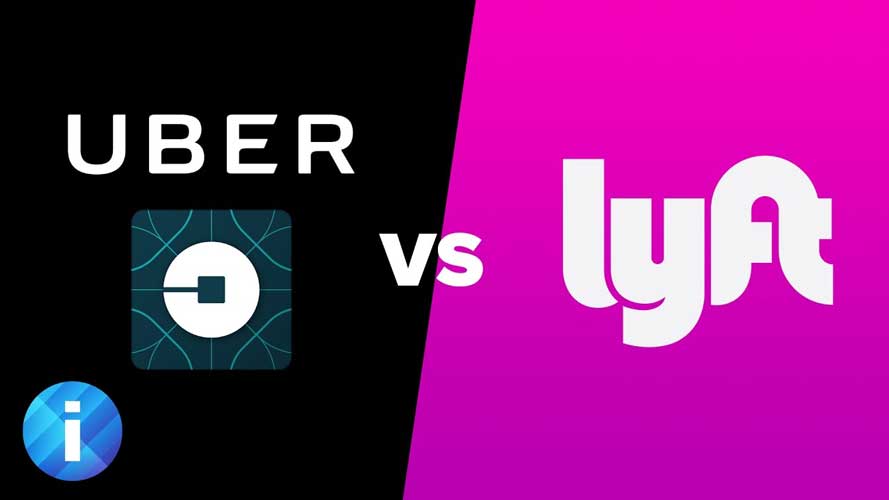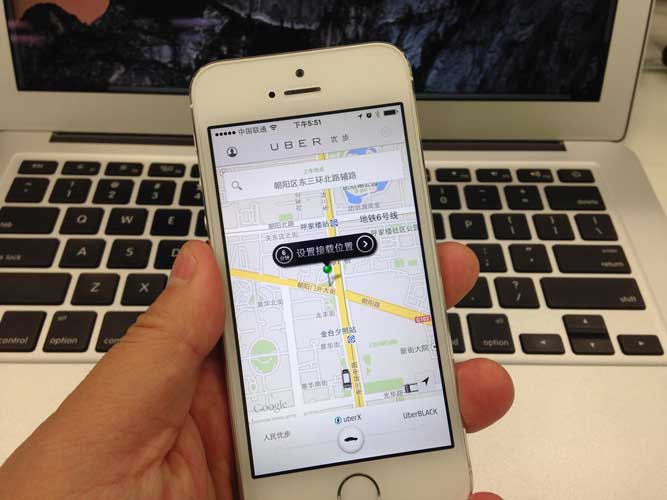The Rideshare Showdown: Lyft vs Uber
On January 29, 2018 by Holly EubanksRidesharing is one of the most revolutionary advancements in the modern transportation industry. It offers customers unprecedented ease of access through simple phone applications, allowing anybody to call for a ride, see information about their driver, and even track the progress of the vehicle.
It has opened a whole new world to taxi drivers as well. Before ridesharing if you wanted to be a taxi driver, you would have to go through a lengthy and tedious application process, then you’d be given a rickety old cab, pay most of your money to the taxi company, and hope you made some extra tips to cover your bills.
With the advent of companies like Uber and Lyft, anybody can use their personal vehicles to make an income. Whether you want to work part-time or full-time, you get to decide what time you clock-in and how many hours a day you work. Sounds pretty great right?

So who’s the best company to drive for? Who’s better to hitch a ride with? In the following article we’re going to examine the differences between the two largest ridesharing competitors, Lyft vs Uber, and take a look at what makes them great, and what makes them not so great.
For Drivers
Both Uber and Lyft both offer certain advantages and disadvantages in their perspective areas. These days, drivers often drive for both companies to maximize their income. They figure out which companies they can make the most money on a particular day or time. Below, we will lay out some of the information that you need to consider when deciding which company to drive for and when you should drive for both.
Location
Obviously, location is a big factor when deciding who to drive for. Lyft is slightly newer to the ridesharing scene than Uber is, and it doesn’t have as big a handle on the market as it competitor.
Statistically, Uber tends to be far more popular in rural areas outside of the reach of big cities. Customers can usually hail a ride within twenty minutes even in small towns. In large metropolitan areas, however, Lyft offers much fiercer competition, rivaling and sometimes even trumping the popularity of Uber.
So check your city and see what the support rate is for both. Another great thing about hard competition is that both companies try to one-up the other by offering better incentives for their drivers. We will go into these incentive programs below.
Rate of Pay
 Let’s face it, the only reason you’re going to purposefully choose to put hundreds of miles a day on your car is that you want to make money. So who are you going to make more money with?
Let’s face it, the only reason you’re going to purposefully choose to put hundreds of miles a day on your car is that you want to make money. So who are you going to make more money with?
The cost for an average Uber or Lyft is about the same:
- $1 to begin your ride
- $.25 per minute spent en route
- $1.50 per mile
So it totals out to right around $2 per mile for an average trip, and the driver usually averages to keep 70-80% of this after the rideshare company takes their share.
Surges
The next thing to look at is surges. Surges are times of the day where there is a high demand for drivers. These are usually lunchtime, rush hour, weekends, or whenever the bars and nightclubs close. The surge prices are usually 1.5 to 2 times the base rate per mile, but in extreme situations can go up to 5 times or more.
RECOMMENDED RESOURCE:
Tips For Making The Most With Uber: Best Time To Drive Uber
The surges are what paper-chasing drivers live for. These are the times when they can really make good money. If a driver plays his cards right, he can make more money on a Friday night surge than he could all week.
This is where driving for both companies can pay out. The fewer drivers there are on one network, the higher the surge amount is. It pays to do your due diligence and figure out whether Uber or Lyft is busier in your city on a particular night. Statistically, though, Lyft isn’t always as popular and well-known as Uber is, so there is the potential to make more money with that if there’s a high demand in your city.
Incentives
Another interesting new thing that both companies have started doing to compete is by offering guaranteed incentive-based programs which keep drivers on the road even during typically slow times and give their drivers motivation to maintain their loyalty to the company. Here are some of the common ones you will see:
- Guaranteed hourly pay
This incentive is competitively offered by both Uber and Lyft to encourage drivers to stay active even during typically slower times. It does the rideshare company’s reputation no good if prospective riders can’t find a vehicle. That means as a driver, you are still making your fare money, but you have a guaranteed hourly pay for a period which is usually around three or four hours. These bonuses can be smaller at around $10 per hour, but they can go up exponentially to upwards of $50 per hour.
- Power bonuses for newer cars
This is an incentive offered by Lyft and gives drivers extra money based on how many trips they gave in a given week. However, to be eligible for this you have to drive a vehicle that’s 2010 or newer.
- Quest
Quest is an Uber incentive that offers drivers extra bonuses for getting passengers to their destinations within a certain amount of time. Besides getting the Quest bonus, passengers are far more likely to tip extra when they get to work on time.
- Power driver
Power driver is an incentive by Uber that’s very similar to Lyft’s power bonuses, with one key difference; drivers have to have given a certain number of rides to get the bonus. Lyft offers bonuses based on a percentage of rides given, but Uber offers larger bonuses, with harder to meet goals. So if you’re a fan of challenges, this gives you a great incentive.
- Boost
Boost is another Uber incentive that can really make drivers a lot of money. What boost does, is it multiplies your trip fare by a guaranteed amount, very similar to surging. The other great thing about boost is that it stacks with the surge, so if you can get lucky enough to get both at once, you’re guaranteed to make some good money.
Tips
Traditionally all cab drivers made their extra money in tips, and even with Uber and Lyft’s incentives that we reviewed, having the ability to make some extra tip money can be a dealbreaker.
Years ago when both companies were new on the scene, Lyft pioneered the tipping feature. Every time a customer got out of the car, they received a quick pop up asking if they wished to tip their driver and give them a quick review. As a result, Lyft customers got into the habit of always tipping their drivers.
Uber on the other hand, only just recently implemented the ability to tip within their app. Beforehand that the only option was to tip in cash, and these days people don’t carry around paper bills as much as they used to. As a result, Uber customers got used to not tipping their drivers for several years. Even with the new ability to tip within the Uber app, customers have become so accustomed to not tipping that drivers are far more likely to get stiffed. On average, Lyft drivers make a lot more tip money than Uber drivers do, so if tips are important to you, make sure you take this into consideration.
Satisfaction
Having satisfaction with the company one works for is an important factor to keep in mind. Overall, Lyft drivers seem to be far more satisfied with their experience. According to a recent survey in 2017, 76% of drivers were satisfied with their Lyft experience, whereas only 49% of Uber drivers reported a positive experience.
A lot of this may have to do with the fact that Lyft drivers earn around $1.50 to $2 more per hour once you include the extra tip money that they make, and so this satisfaction percentage could change over the course of the next year now that Uber has implemented tipping into their app.
Many people who have driven for both companies claim that Lyft offers a better driving experience, and has more incentives readily available. Looking closer at individuals who work for both companies, you’ll notice that they typically drive more for Uber than they do Lyft, but prefer to drive for Lyft over Uber. This indicates that if Lyft were to grow bigger and offer the volume that Uber currently provides, that Lyft could have a good chance of massively trumping out Uber in driver ratings.
Vehicle Requirements
Both Uber and Lyft are comparable when it comes to driver requirements. In most cases, Lyft tends to be a bit more strict than Uber. The general requirements for the base level service both are as follows:
UberX Requirements
- Vehicle year of 2002 or newer
- Vehicle must be clean, presentable, and have minimal cosmetic damage. Small scratches are usually fine
- The vehicle must have four doors
- Super Duty trucks or commercial vans are prohibited
- No commercial branding or banners are allowed on the vehicle
- Vehicle must pass the Uber Vehicle Inspection
Lyft Requirements
- Vehicle year of 2006 or newer
- Vehicle must be clean, Air Conditioning and heat must work
- Must have four doors
- No commercial vehicles are allowed
- Vehicle must be able to pass the Lyft Vehicle Inspection
As you can see, the main difference is that Lyft requires a slightly newer vehicle, but this is all dependent upon location. Certain states will require you have a newer vehicle to meet certain emission and safety standards, so make sure to double check your state’s specific regulations.
Driving in Luxury
Speaking of vehicles, let’s compare Uber and Lyft regarding their luxury service levels that they provide. Often if you have a luxury vehicle that meets minimum requirements, you can make a hefty bonus by giving rides to high-end clientele.
Uber offers the following luxury services:
- Uber Select – Includes most base model luxury or sport-luxury models
- Uber Black – This is Uber’s premier concierge service. They have stricter luxury requirements than Uber Select and require that your vehicle have an all-black interior and exterior
- UberSUV – UberSUV provides the same service as Uber Black but offers large SUV’s that must be able to seat at least six people. Aside from luxury requirements, your SUV must also be all-black
- UberLUX – This is the next level up from Uber Black. Drivers are required to rent or own exotic or high-end, fully loaded luxury vehicles such as Maybachs, Bentleys, or Rolls Royce
Lyft recently decided to compete with Uber’s luxury services and offers similar packages:
- Lyft Premier – Similar to Uber Select offers base models of four-door luxury or luxury-sport sedans
- Lyft Lux – Offers higher-end luxury cars with an all-black interior and exterior
- Lyft Lux Suv – Similar to UberSUV offers high-end all-black SUV’s which must be able to seat at least six people
Now, these services are relatively the same, so you may wonder why I said earlier that Uber has the advantage in this field. This is because of one key factor; Uber offers their luxury services in almost every major city, whereas Lyft only provides their luxury services primarily in Toronto and the Greater Toronto Area in Canada. They do however have plans to expand to most major US cities by mid-2018, but until then Lyft drivers are out of luck if they had hoped to provide luxury rides outside of Canada.
Driver Requirements
Now let’s talk about Uber and Lyft’s requirements for their drivers. They both want to ensure that their company is represented by individuals who have proven themselves to be good drivers and have a clean criminal record, but here is a list of general requirements:
Uber
- You must be 21 years old to apply
- You must have had a drivers license for one year, and if you’re under the age of 23 you must have had your license for three years
- Must have vehicle insurance in your name
- Your vehicle must be registered and have plates in the state you’ll be operating in
- Drivers must pass a criminal background check
Lyft
- You must be 21 years old to apply
- You must have had a drivers license for one year and have a clean driving record
- Must have a vehicle insurance policy in your name
- Your vehicle must be registered with plates in your state
- Drivers must pass a criminal background check in addition to the driving record check
As you can see, pretty similar, with a couple of differences. Uber requires three years of driving experience for applicants under the age of 23, and Lyft requires all their prospective drivers to pass a driving evaluation, and complete a training day with a Lyft associate. Ubers higher age restriction and Lyft’s driving test are both ways of ensuring that their drivers are capable of performing their job safely. If either company were to rack up a high percentage of accidents, it could be detrimental to their future.
Read more: Uber Car Requirements
For Riders
Maybe you’re not trying to drive, and instead, you’re just curious as to which ridesharing company provides the best experience for the riders.
Cost
Outside of the special surge pricing times (or “prime time” as Lyft calls it), reports have shown that on average, getting a ride from Lyft is a little bit cheaper than Uber in major cities like Los Angeles, San Francisco, and New York City.
Granted the differences between rates is marginal at best. Due to the high competition between Uber and Lyft, they are always trying to provide better, cheaper service than the other, so any major discount offered by one is quickly countered by a discount or offer by the other.
All fees included, the average cost totals out to around $2 per mile riding with both Uber and Lyft, not including any additional surge pricing.
Tipping
As mentioned above, Lyft has always provided a way for riders to tip their drivers from their app, and Uber has recently followed suit. Should you wish to tip your driver, you will be given a quick pop-up in your Uber or Lyft app after you are dropped off which prompts you to rate and review your driver, also giving you the ability to tip them. They have buttons for 10%, 15%, 20%, and 25% tips which are automatically calculated based on your ride cost, or you can choose to add a custom tip. The tip will be added to your receipt the following business day and will be taken from the payment method you have set in your app.
App Usability

App usability and functionality is key when customers are looking to find an easy ride. Many times riders are in a hurry to get to work, standing in the cold or bad weather, or slightly inebriated after a night of drinking. Providing an app that is transparent, easy to use, and relatively simple is important to giving people the customer experience needed to keep coming back.
Upon review, both the Uber and the Lyft application share the same basic features. Both apps are available for Android, iOS, and Windows Phone operating systems, so pretty much anybody with a smartphone can access them.
Both Google Maps and Apple maps have also integrated Uber functionality into their system, so you can see and hail drivers around your area. This is an interesting feature and offers a way for somebody who might be lost and staring at their mapping app to easily request a ride without having to switch applications.
As far as simplicity goes, both apps have become increasingly more complex which can affect individuals who aren’t as familiar with modern technology. The complexity and extra features are great for the tech-savvy and offer them an enhanced user experience, but this falls short on those who lack tech know-how.
One small difference to take note of is Uber’s transparency when compared to Lyft. Uber gives customers a better idea of what their final fare price is going to be before they pay, whereas Lyft requires you to do a little bit of extra work. Within the Lyft app you can request a ‘fare quote’, but they don’t offer it up in plain sight the way that Uber does. If you’re a rider who’s conscious of their spending, Uber is looking out for you.
As Uber has expanded into delivery and luxury services over the past year, their app has become slightly more clogged with advertisements and promotions for these services. Thankfully it’s not excessive, but it is noticeable, and if you’re not a fan of seeing these promotions, it might turn you away from the Uber app.
Aside from these slight differences though, both apps work well and function on the same level. In most big cities, riders will have both the Uber and Lyft apps downloaded and tend to hitch a ride with whoever is offering cheaper fare or quicker response time.
Rider Experience
Over the past year, Uber has picked up some flack for a few freak accidents and several sexual misconduct allegations against some of their drivers. While unfortunate, Uber has done their best to crack down even harder when conducting criminal background checks to prevent unsavory characters from obtaining driver status.

Overall, customers seem almost equally satisfied with both Uber and Lyft. Obviously riders will tend to be biased towards whoever’s cheaper on a given day, but in general, prices remain very similar.
Most rideshare drivers are also very friendly as their tip depends upon it. For those visiting new cities or in unfamiliar areas, Uber and Lyft drivers can be some of the best sources of information. They spend all day traveling around their city and can usually recommend a wide variety of tourist attractions, good eats, and popular nightlife locations.
Depending on what city you reside in and how friendly the people are, many drivers will even help you with your luggage and provide water or snacks to riders.
Availability
Availability is an important consideration, and both companies provide service in over 400 countries. Uber, however, tends to be more readily available in smaller towns and cities, whereas Lyft primarily operates in and around major metropolitan areas. If you live in a rural area, Uber can usually provide response times of under 20 minutes, and in most big cities, you’re guaranteed a ride from either Uber or Lyft in under 10 minutes.
In Conclusion
Both Uber and Lyft offer an exceptional service at an affordable price. They’re cheaper and provide nicer vehicles for customers to ride in than traditional taxis, and have opened up a goldmine for potential entrepreneurs.
In the article above we detailed the primary differences and small nuances that make each company stand out from the other in comparison, however, as far as who the better of the two competitors is, there is no cut and dry answer and that is a question that you will have to answer yourself with your own experiences.
Archives
Calendar
| M | T | W | T | F | S | S |
|---|---|---|---|---|---|---|
| « Jan | ||||||
| 1 | 2 | |||||
| 3 | 4 | 5 | 6 | 7 | 8 | 9 |
| 10 | 11 | 12 | 13 | 14 | 15 | 16 |
| 17 | 18 | 19 | 20 | 21 | 22 | 23 |
| 24 | 25 | 26 | 27 | 28 | 29 | 30 |
| 31 | ||||||
Leave a Reply